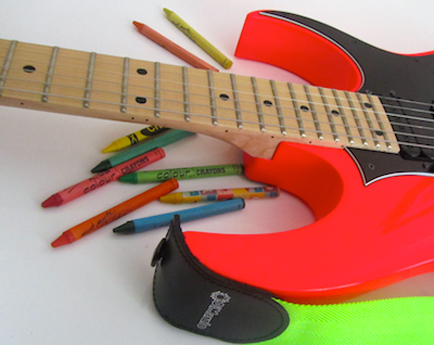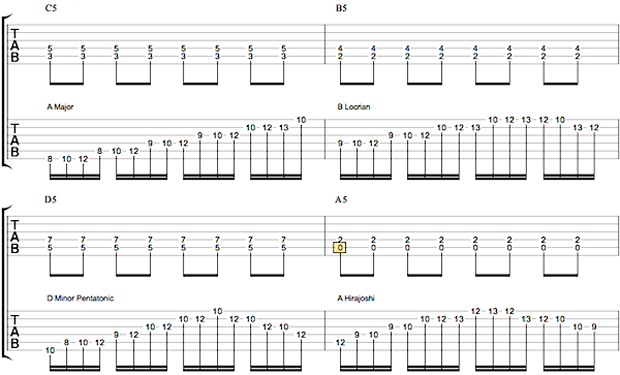Synesthesia and the Musical Mind
If you don't happen to have synesthesia, that doesn't mean you can't use its general concept as a compositional tool.

Every now and then, I'll interview someone who credits part of their musical inspiration to synesthesia—a phenomenon where one kind of sensory input triggers another.
A common example is the perception of colors or textures in relation to music. I'm fortunate to have this trait myself, along with a few other odd little synesthesia-related quirks; I subconsciously associate odd numbers and angular shapes with warm colors, and even numbers and smooth shapes with cool colors, for instance.
And synesthesia also evokes some pretty vivid color perceptions in relation to scales and modes.
Learning a new scale is like getting a new Crayon: Even though its color is a mixture of other colors that you might already have available, there's something magical and unique about each crayon and each color—and you can use it to create a different mood.
To translate this back to a musical example, the notes of the D minor pentatonic scale—D, F, G, A, C—are also contained within the C major scale (C, D, E, F, G, A, B). Yet the two scales have completely different feels. And if you play C major starting on the B and use that as the root note, you're playing B Locrian (B, C, D, E, F, G, A), which again has a different color to D minor pentatonic or C major. Yet they all contain a D, an F, a G, an A and a C. It's as if the minor pentatonic is blue, the major is green (blue + yellow) and the Dorian is purple (blue + red).
And in a similar way, if you chip out selected notes from one scale, you'll end up with another, more minimal one. My favorite example of this is the Hirajoshi scale. Like the minor pentatonic, it's a five-note scale that can be arrived at by starting with the major scale, zeroing in on a different root and stripping a few notes away. In the key of A, Hirajoshi's notes are A, B, C, E and F.
Now here's where things get super-fun. Since each of these scales is built using the same notes found within C major, you can construct a four-bar sequence to jam over, using the same exact pool of notes but evoking an entirely different color depending on which chord you're playing over and which notes you leave out.
Here's an example, using a bar each of C major, B Locrian, D minor pentatonic and A Hirajoshi. In each bar you'll just run the scale up and down, which will give you a nice overview of the general character of the scale, but once you have it under your fingers you should swap out the plain scale runs for actual melodies constructed of those notes.

I use a little bit of this idea in the solo of my song "Hyperreality."
The solo starts in E Akebono (which happens to use the same exact notes as A Hirajoshi, but with E as the root) before adding other notes as it progresses, including stuff from E Minor and E minor pentatonic, and even a few chromatic passing tones. Akebono and Hirajoshi have a cool Jason Becker-type feel to them, and the distance between the F and the A, and the C and the E makes for some really interesting musical moods.
If you don't happen to have synesthesia, that doesn't mean you can't use its general concept as a compositional tool. It doesn't matter whether you naturally perceive a scale as a color or if you arbitrarily assign one to it for inspiration. Just because I feel A Akebono as sort of purple with about two dozen little flecks of silver per square inch doesn't mean you can't decide that it's green with yellow polka dots.
Peter Hodgson is a journalist, an award-winning shredder, an instructional columnist, a guitar teacher, a guitar repair guy, a dad and an extremely amateur barista. In his spare time he runs a blog, I Heart Guitar, which allows him to publicly geek out over his obsessions. Peter is from Melbourne, Australia, where he writes for various magazines, including Guitar World.
Get The Pick Newsletter
All the latest guitar news, interviews, lessons, reviews, deals and more, direct to your inbox!
Peter Hodgson is a journalist, an award-winning shredder, an instructional columnist, a guitar teacher, a guitar repair guy, a dad and an extremely amateur barista. He runs a blog, I Heart Guitar, which allows him to publicly geek out over his obsessions. Peter is from Melbourne, Australia, where he writes for various magazines, including Guitar World.
“There are so many sounds to be discovered when you get away from using a pick”: Jared James Nichols shows you how to add “snap, crackle and pop” to your playing with banjo rolls and string snaps
Don't let chord inversions bamboozle you. It's simply the case of shuffling the notes around







![Joe Bonamassa [left] wears a deep blue suit and polka-dotted shirt and plays his green refin Strat; the late Irish blues legend Rory Gallagher [right] screams and inflicts some punishment on his heavily worn number one Stratocaster.](https://cdn.mos.cms.futurecdn.net/cw28h7UBcTVfTLs7p7eiLe.jpg)


